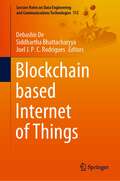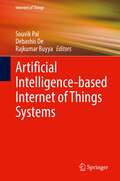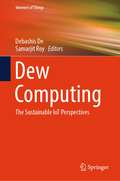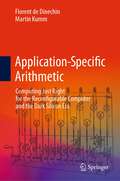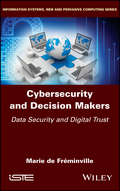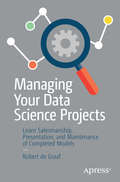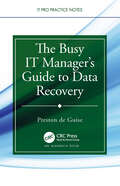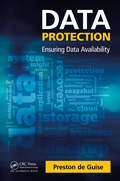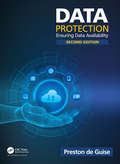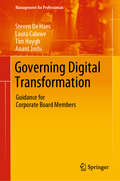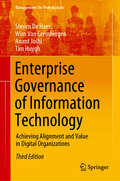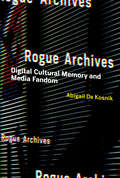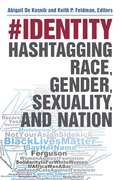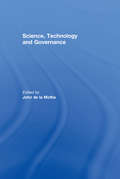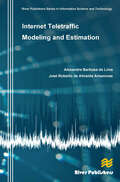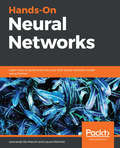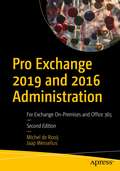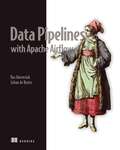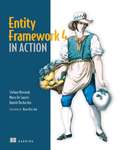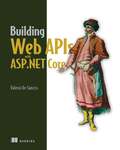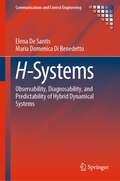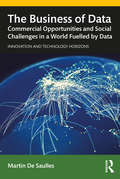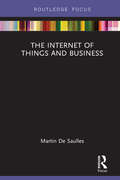- Table View
- List View
Blockchain based Internet of Things (Lecture Notes on Data Engineering and Communications Technologies #112)
by Debashis De Siddhartha Bhattacharyya Joel J. P. C. RodriguesThe book is aimed to foster knowledge based on Blockchain technology highlighting on the framework basics, operating principles and different incarnations. The fundamental problems encountered in existing blockchain architectures and means for removing those would be covered. It would also touch upon blockchain based IoT systems and applications. The book covers applications and use cases of blockchain technology for industrial IoT systems. In addition, methods for inducing computational intelligence into existing blockchain frameworks thereby thwarting most of the limitations are also discussed. The readers would benefit from the rich technical content in this rapidly emerging field thereby enabling a skilled workforce for the future.
Artificial Intelligence-based Internet of Things Systems (Internet of Things)
by Debashis De Rajkumar Buyya Souvik PalThe book discusses the evolution of future generation technologies through Internet of Things (IoT) in the scope of Artificial Intelligence (AI). The main focus of this volume is to bring all the related technologies in a single platform, so that undergraduate and postgraduate students, researchers, academicians, and industry people can easily understand the AI algorithms, machine learning algorithms, and learning analytics in IoT-enabled technologies. This book uses data and network engineering and intelligent decision support system-by-design principles to design a reliable AI-enabled IoT ecosystem and to implement cyber-physical pervasive infrastructure solutions. This book brings together some of the top IoT-enabled AI experts throughout the world who contribute their knowledge regarding different IoT-based technology aspects.
Dew Computing: The Sustainable IoT Perspectives (Internet of Things)
by Debashis De Samarjit RoyThis book discusses the dew computing paradigm with the evolution of future-generation technologies through the cloud and the Internet of Things in the scope of machine intelligence. Dew computing is an emerging paradigm that inherits a flexible and super-hybrid methodology to afford personal information to users with self-regulating internetwork connectivity. The contents conceptualize how the end-users can benefit from data analytics through intelligent data sensing, computing, analytics, and distributed scenarios using a dew-cloud computational framework over the Internet of Things environment. The main focus of this book is to bring all the related technologies into a single platform so that undergraduate and postgraduate students, researchers, academicians, and the industry can easily understand dew computing, future generations of cloud computing, machine intelligence, and representation learning in IoT-enabled technologies.
Application-Specific Arithmetic: Computing Just Right for the Reconfigurable Computer and the Dark Silicon Era
by Florent de Dinechin Martin KummWritten by two experts of the domain, this book presents the most recent advances in computer arithmetic hardware, with a focus on application-specific arithmetic beyond the classic operators and the standard precisions. It targets silicon designers who have to do better with less in the post-Moore era, and FPGA developers who want to exploit the full possibilities of reconfigurable computing platforms.
Cybersecurity and Decision Makers: Data Security and Digital Trust
by Marie De FréminvilleCyber security is a key issue affecting the confidence of Internet users and the sustainability of businesses. It is also a national issue with regards to economic development and resilience. As a concern, cyber risks are not only in the hands of IT security managers, but of everyone, and non-executive directors and managing directors may be held to account in relation to shareholders, customers, suppliers, employees, banks and public authorities. The implementation of a cybersecurity system, including processes, devices and training, is essential to protect a company against theft of strategic and personal data, sabotage and fraud. Cybersecurity and Decision Makers presents a comprehensive overview of cybercrime and best practice to confidently adapt to the digital world; covering areas such as risk mapping, compliance with the General Data Protection Regulation, cyber culture, ethics and crisis management. It is intended for anyone concerned about the protection of their data, as well as decision makers in any organization.
Managing Your Data Science Projects: Learn Salesmanship, Presentation, and Maintenance of Completed Models
by Robert de GraafAt first glance, the skills required to work in the data science field appear to be self-explanatory. Do not be fooled. Impactful data science demands an interdisciplinary knowledge of business philosophy, project management, salesmanship, presentation, and more. In Managing Your Data Science Projects, author Robert de Graaf explores important concepts that are frequently overlooked in much of the instructional literature that is available to data scientists new to the field. If your completed models are to be used and maintained most effectively, you must be able to present and sell them within your organization in a compelling way.The value of data science within an organization cannot be overstated. Thus, it is vital that strategies and communication between teams are dexterously managed. Three main ways that data science strategy is used in a company is to research its customers, assess risk analytics, and log operational measurements. These all require different managerial instincts, backgrounds, and experiences, and de Graaf cogently breaks down the unique reasons behind each. They must align seamlessly to eventually be adopted as dynamic models.Data science is a relatively new discipline, and as such, internal processes for it are not as well-developed within an operational business as others. With Managing Your Data Science Projects, you will learn how to create products that solve important problems for your customers and ensure that the initial success is sustained throughout the product’s intended life. Your users will trust you and your models, and most importantly, you will be a more well-rounded and effectual data scientist throughout your career.Who This Book Is ForEarly-career data scientists, managers of data scientists, and those interested in entering the field of data science
The Busy IT Manager’s Guide to Data Recovery (IT Pro Practice Notes)
by Preston de GuiseNo IT manager or worker enjoys being woken up the middle of the night over a system fault. But arguably the worst way to be awakened is over a situation where data loss has occurred – and the recovery is going wrong. The Busy IT Manager’s Guide to Data Recovery takes a razor focus on the details IT managers (and their teams) responsible for data recovery and resiliency within their business need to be aware of in the design of robust data protection systems. This book covers key architectural requirements of a data resilient system and the types of technology a business can deploy for data protection that maximises the potential for a successful recovery. With cyber-attacks being a daily challenge for IT and business now, the book also takes an in-depth look at the special considerations companies need to take in order to guarantee the recoverability of data after a destructive cyber event. Regardless of whether your IT infrastructure runs on-premises or in the public cloud, this book gives you the information you need to plan and run a successful data recovery solution that meets your business needs. Preston de Guise has been working with data recovery products for his entire career – designing, implementing, and supporting solutions for governments, universities, and businesses ranging from SMEs to Fortune 500 companies. This broad exposure to industry verticals and business sizes has enabled Preston to understand not only the technical requirements of data protection and recovery, but the management and procedural aspects too.
Data Protection: Ensuring Data Availability
by Preston de GuiseThis is the fundamental truth about data protection: backup is dead. Or rather, backup and recovery, as a standalone topic, no longer has relevance in IT. As a standalone topic, it’s been killed off by seemingly exponential growth in storage and data, by the cloud, and by virtualization. So what is data protection? This book takes a holistic, business-based approach to data protection. It explains how data protection is a mix of proactive and reactive planning, technology and activities that allow for data continuity. It shows how truly effective data protection comes from a holistic approach considering the entire data lifecycle and all required SLAs. Data protection is neither RAID nor is it continuous availability, replication, snapshots or backups—it is all of them, combined in a considered and measured approach to suit the criticality of the data and meet all the requirements of the business. The book also discusses how businesses seeking to creatively leverage their IT investments and to drive through cost optimization are increasingly looking at data protection as a mechanism to achieve those goals. In addition to being a type of insurance policy, data protection is becoming an enabler for new processes around data movement and data processing. This book arms readers with information critical for making decisions on how data can be protected against loss in the cloud, on-premises, or in a mix of the two. It explains the changing face of recovery in a highly virtualized data center and techniques for dealing with big data. Moreover, it presents a model for where data recovery processes can be integrated with IT governance and management in order to achieve the right focus on recoverability across the business.
Data Protection: Ensuring Data Availability
by Preston de GuiseThe second edition of Data Protection goes beyond the traditional topics including deduplication, continuous availability, snapshots, replication, backup, and recovery, and explores such additional considerations as legal, privacy, and ethical issues. A new model is presented for understanding and planning the various aspects of data protection, which is essential to developing holistic strategies. The second edition also addresses the cloud and the growing adoption of software and function as a service, as well as effectively planning over the lifespan of a workload: what the best mix of traditional and cloud native data protection services might be. Virtualization continues to present new challenges to data protection, and the impact of containerization is examined. The book takes a holistic, business-based approach to data protection. It explains how data protection is a mix of proactive and reactive planning, technology, and activities that allow for data continuity. There are three essential activities that refer to themselves as data protection; while they all overlap in terms of scope and function, each operates as a reasonably self-contained field with its own specialists and domain nomenclature. These three activities are: • Data protection as a storage and recovery activity • Data protection as a security activity • Data protection as a privacy activity These activities are covered in detail, with a focus on how organizations can use them to leverage their IT investments and optimize costs. The book also explains how data protection is becoming an enabler for new processes around data movement and data processing. This book arms readers with information critical for making decisions on how data can be protected against loss in the cloud, on premises, or in a mix of the two. It explains the changing face of recovery in a highly virtualized datacenter and techniques for dealing with big data. Moreover, it presents a model for where data recovery processes can be integrated with IT governance and management in order to achieve the right focus on recoverability across the business. About the Author Preston de Guise has been working with data recovery products for his entire career—designing, implementing, and supporting solutions for governments, universities, and businesses ranging from SMEs to Fortune 500 companies. This broad exposure to industry verticals and business sizes has enabled Preston to understand not only the technical requirements of data protection and recovery, but the management and procedural aspects too.
Governing Digital Transformation: Guidance for Corporate Board Members (Management for Professionals)
by Steven De Haes Laura Caluwe Tim Huygh Anant JoshiThis title provides clear and readily applicable guidance to corporate board members on the involvement of boards of directors in information technology (IT) governance. Specifically, it demonstrates ways in which board members can execute IT duties effectively. Specific tools such as a roadmap towards digital transformation and a board-level dashboard for digital strategy and oversight are also offered. While organizations are increasingly dependent on IT for the creation of business value, the evidence seems to indicate that boards of directors are not as involved in IT-related strategic decision-making and control as they should be. Research shows that high levels of board-level IT governance, regardless of existing IT needs, will improve organizational performance. This book provides unique insights into the inner workings of a specific board of directors group, with a focus on its IT governance structures and processes.
Enterprise Governance of Information Technology: Achieving Alignment and Value in Digital Organizations (Management for Professionals)
by Steven De Haes Wim Van Grembergen Anant Joshi Tim HuyghThis book integrates theoretical advances and empirical data on Enterprise Governance in Information Technology (EGIT) with practical applications based on numerous case examples. The third revised edition of Enterprise Governance of Information Technology provides professionals and students with the most recent research advancements as well as an in-depth discussion of the recently-introduced Control Objectives for Information and Related Technologies (COBIT) 2019 framework which can be used to facilitate a tailored implementation of effective EGIT. Furthermore, the book features a new chapter which provides readers with hands-on examples from practice and clear insights on how these relate to theory. At the forefront of the field, the authors of this volume draw from years of research and advising corporate clients to present a comprehensive resource on EGIT. Featuring a variety of elements, including executive summaries and sidebars, extensive references, questions and activities and additional online materials, this book is a valuable updated resource for professionals, students and researchers alike.
Rogue Archives: Digital Cultural Memory and Media Fandom
by Abigail De KosnikAn examination of how nonprofessional archivists, especially media fans, practice cultural preservation on the Internet and how “digital cultural memory” differs radically from print-era archiving.The task of archiving was once entrusted only to museums, libraries, and other institutions that acted as repositories of culture in material form. But with the rise of digital networked media, a multitude of self-designated archivists—fans, pirates, hackers—have become practitioners of cultural preservation on the Internet. These nonprofessional archivists have democratized cultural memory, building freely accessible online archives of whatever content they consider suitable for digital preservation. In Rogue Archives, Abigail De Kosnik examines the practice of archiving in the transition from print to digital media, looking in particular at Internet fan fiction archives.De Kosnik explains that media users today regard all of mass culture as an archive, from which they can redeploy content for their own creations. Hence, “remix culture” and fan fiction are core genres of digital cultural production. De Kosnik explores, among other things, the anticanonical archiving styles of Internet preservationists; the volunteer labor of online archiving; how fan archives serve women and queer users as cultural resources; archivists' efforts to attract racially and sexually diverse content; and how digital archives adhere to the logics of performance more than the logics of print. She also considers the similarities and differences among free culture, free software, and fan communities, and uses digital humanities tools to quantify and visualize the size, user base, and rate of growth of several online fan archives.
#identity: Hashtagging Race, Gender, Sexuality, and Nation
by Abigail De Kosnik Keith FeldmanSince its launch in 2006, Twitter has served as a major platform for political performance, social justice activism, and large-scale public debates over race, ethnicity, gender, sexuality, and nationality. It has empowered minoritarian groups to organize protests, articulate often-underrepresented perspectives, and form community. It has also spread hashtags that have been used to bully and silence women, people of color, and LGBTQ people. #identity is among the first scholarly books to address the positive and negative effects of Twitter on our contemporary world. Hailing from diverse scholarly fields, all contributors are affiliated with The Color of New Media, a scholarly collective based at the University of California, Berkeley. The Color of New Media explores the intersections of new media studies, critical race theory, gender and women’s studies, and postcolonial studies. The essays in #identity consider topics such as the social justice movements organized through #BlackLivesMatter, #Ferguson, and #SayHerName; the controversies around #WhyIStayed and #CancelColbert; Twitter use in India and Africa; the integration of hashtags such as #nohomo and #onfleek that have become part of everyday online vernacular; and other ways in which Twitter has been used by, for, and against women, people of color, LGBTQ, and Global South communities. Collectively, the essays in this volume offer a critically interdisciplinary view of how and why social media has been at the heart of US and global political discourse for over a decade.
Science, Technology and Global Governance (Science And Technology In The Ipe Ser.)
by John R. De La MotheFirst published in 2001. Routledge is an imprint of Taylor & Francis, an informa company.
Internet Teletraffic Modeling and Estimation (River Publishers Series In Information Science And Technology Ser.)
by Alexandre Barbosa de Lima Jose Roberto AmazonasNetwork traffic has fractal properties such as impulsiveness, selfsimilarity, and long-range dependence over several time scales, from milliseconds to minutes. These features have motivated the development of new traffic models and traffic control algorithms. This book presents a new statespace model for Internet traffic, which is based on a finite-dimensional representation of the Autoregressive Fractionally Integrated Moving Average (ARFIMA) random process. The modeling via Autoregressive (AR) processes is also investigated.
Hands-On Neural Networks: Learn how to build and train your first neural network model using Python
by Leonardo De Marchi Laura MitchellDesign and create neural networks with deep learning and artificial intelligence principles using OpenAI Gym, TensorFlow, and KerasKey FeaturesExplore neural network architecture and understand how it functionsLearn algorithms to solve common problems using back propagation and perceptronsUnderstand how to apply neural networks to applications with the help of useful illustrationsBook DescriptionNeural networks play a very important role in deep learning and artificial intelligence (AI), with applications in a wide variety of domains, right from medical diagnosis, to financial forecasting, and even machine diagnostics.Hands-On Neural Networks is designed to guide you through learning about neural networks in a practical way. The book will get you started by giving you a brief introduction to perceptron networks. You will then gain insights into machine learning and also understand what the future of AI could look like. Next, you will study how embeddings can be used to process textual data and the role of long short-term memory networks (LSTMs) in helping you solve common natural language processing (NLP) problems. The later chapters will demonstrate how you can implement advanced concepts including transfer learning, generative adversarial networks (GANs), autoencoders, and reinforcement learning. Finally, you can look forward to further content on the latest advancements in the field of neural networks.By the end of this book, you will have the skills you need to build, train, and optimize your own neural network model that can be used to provide predictable solutions.What you will learnLearn how to train a network by using backpropagationDiscover how to load and transform images for use in neural networksStudy how neural networks can be applied to a varied set of applicationsSolve common challenges faced in neural network developmentUnderstand the transfer learning concept to solve tasks using Keras and Visual Geometry Group (VGG) networkGet up to speed with advanced and complex deep learning concepts like LSTMs and NLP Explore innovative algorithms like GANs and deep reinforcement learningWho this book is forIf you are interested in artificial intelligence and deep learning and want to further your skills, then this intermediate-level book is for you. Some knowledge of statistics will help you get the most out of this book.
Sencha Touch in Action
by Anthony De Moss Mitchell Simoens Jesus GarciaSummarySencha Touch in Action is the definitive guide to developing applications with Sencha Touch. You'll begin with basic design principles for building great mobile applications, and then explore the features of Sencha Touch that bring those ideas to life. You'll learn how and why objects operate in the framework as you work through several real-world examples. This book also promotes the emerging best practices for mobile web development, from widget implementation to developing an application with the Sencha Touch MVC framework. Updated for Sencha Touch 2.About the TechnologyThe Sencha Touch framework makes it easy to build cross-platform mobile apps using HTML5 and JavaScript. It offers numerous features that mimic native mobile APIs and an MVC architecture that feels right at home for application developers. So you get the power and richness of native apps and the convenience of standard web tools.About this BookSencha Touch in Action is a complete guide for developers of native-quality mobile Sencha Touch applications. You'll explore real-world examples as you master this impressive framework from the ground up. The book shows you good practices for mobile web development, from widget implementation to the structure of MVC applications.The book requires basic JavaScript skills. It assumes no experience with Sencha Touch or Ext JS.What's InsideCovers Sencha Touch 2Build on your existing web dev skillsCreate mobile web apps that feel like native appsExtend enterprise apps to mobile clientsPurchase of the print book includes a free eBook in PDF, Kindle, and ePub formats from Manning Publications.About the AuthorsJay Garcia is a popular speaker, Sencha community advocate, and author of Ext JS in Action. Anthony De Moss is a professional web and mobile developer. Mitchell Simoens is a Sencha developer supporting the Sencha Touch and Ext JS products.Table of ContentsPART 1 INTRODUCTION TO SENCHA TOUCHIntroducing Sencha TouchUsing Sencha Touch for the first timeSencha Touch foundationsPART 2 BUILDING MOBILE USER INTERFACESMastering the building blocksToolbars, buttons, and docked itemsGetting the user's attentionData stores and viewsWorking with formsMaps and mediaPART 3 CONSTRUCTING AN APPLICATIONClass system foundationsBuilding Sencha Touch applications
Immunoinformatics
by Rajat K. De Namrata TomarAt the intersection of experimental and computational sciences, the second edition of Immunoinformatics provides biological insights as well as a simpler way to implement approaches and algorithms in the immunoinformatics research domain. After an introductory section, this extensive volume moves on to cover topics such as databases, tools for prediction, systems biology approaches, as well as a variety of immunoinformatics applications. As part of the highly successful Methods in Molecular Biology series, chapters include the type of detailed information and implementation advice to ensure successful results. Comprehensive and practical, Immunoinformatics, Second Edition aims at students and researchers from diverse backgrounds and levels interested in working with immunological problems.
Pro Exchange 2019 and 2016 Administration: For Exchange On-Premises and Office 365
by Michel de Rooij Jaap WesseliusUse this one-stop resource for both basic and advanced administration of Exchange Server 2019 and 2016. It will help you in running an Exchange environment, whether it be 100% on-premises or a hybrid configuration with Exchange Online (as part of Office 365).This revised version is divided into four parts, describing Exchange infrastructure, upgrading Exchange server, integration with Office 365, and security and compliance. In the first part, you will go through a short introduction of Exchange server followed by its installation and configuration. You will learn client access along with Exchange mailbox and managing Exchange recipients. In the second part, you will learn how to upgrade from Exchange 2010 to 2016 and from 2013 to Exchange 2019. The third part is dedicated to the Exchange integration with Office 365, followed by the last part that teaches you how to secure your Exchange environment and its compliance.After reading this book, you will understand best practices, do’s and don’ts, and notes from the field to migrate and work on Exchange 2016 and 2019.What You Will LearnCreate a highly available and redundant Exchange environmentUnderstand security, message hygiene (CEO fraud, for example), and complianceKnow the infrastructure changes in Exchange 2019Integrate and manage hybrid recipientsWho This Book Is ForIT pros who are responsible for building and maintaining an Exchange environment, both on-premises and in a hybrid configuration with Exchange Online
Data Pipelines with Apache Airflow
by Julian de Ruiter Bas HarenslakData Pipelines with Apache Airflow teaches you how to build and maintain effective data pipelines.Summary A successful pipeline moves data efficiently, minimizing pauses and blockages between tasks, keeping every process along the way operational. Apache Airflow provides a single customizable environment for building and managing data pipelines, eliminating the need for a hodgepodge collection of tools, snowflake code, and homegrown processes. Using real-world scenarios and examples, Data Pipelines with Apache Airflow teaches you how to simplify and automate data pipelines, reduce operational overhead, and smoothly integrate all the technologies in your stack. Purchase of the print book includes a free eBook in PDF, Kindle, and ePub formats from Manning Publications. About the technology Data pipelines manage the flow of data from initial collection through consolidation, cleaning, analysis, visualization, and more. Apache Airflow provides a single platform you can use to design, implement, monitor, and maintain your pipelines. Its easy-to-use UI, plug-and-play options, and flexible Python scripting make Airflow perfect for any data management task. About the book Data Pipelines with Apache Airflow teaches you how to build and maintain effective data pipelines. You&’ll explore the most common usage patterns, including aggregating multiple data sources, connecting to and from data lakes, and cloud deployment. Part reference and part tutorial, this practical guide covers every aspect of the directed acyclic graphs (DAGs) that power Airflow, and how to customize them for your pipeline&’s needs. What's inside Build, test, and deploy Airflow pipelines as DAGs Automate moving and transforming data Analyze historical datasets using backfilling Develop custom components Set up Airflow in production environments About the reader For DevOps, data engineers, machine learning engineers, and sysadmins with intermediate Python skills. About the author Bas Harenslak and Julian de Ruiter are data engineers with extensive experience using Airflow to develop pipelines for major companies. Bas is also an Airflow committer. Table of Contents PART 1 - GETTING STARTED 1 Meet Apache Airflow 2 Anatomy of an Airflow DAG 3 Scheduling in Airflow 4 Templating tasks using the Airflow context 5 Defining dependencies between tasks PART 2 - BEYOND THE BASICS 6 Triggering workflows 7 Communicating with external systems 8 Building custom components 9 Testing 10 Running tasks in containers PART 3 - AIRFLOW IN PRACTICE 11 Best practices 12 Operating Airflow in production 13 Securing Airflow 14 Project: Finding the fastest way to get around NYC PART 4 - IN THE CLOUDS 15 Airflow in the clouds 16 Airflow on AWS 17 Airflow on Azure 18 Airflow in GCP
Entity Framework 4 in Action
by Marco De Sanctis Stefano Mostarda Daniele BochicchioSummaryEntity Framework 4 in Action is an example-rich tutorial for .NET developers with full coverage of EF 4 features. The book begins with a review of the core ideas behind the ORM model and shows through detailed examples and larger case studies how Entity Framework offers a smooth transition from a traditional ADO.NET approach.About the TechnologyEntity Framework builds on the ADO.NET persistence model and the language features of LINQ to create a powerful persistence mechanism that bridges the gap between relational databases and object-oriented languages.About the BookEntity Framework 4 in Action is an example-rich tutorial that helps .NET developers learn and master the subject. It begins by explaining object/relational mapping and then shows how you can easily transition to EF from ADO.NET. Through numerous focused examples and two larger case studies, the book unfolds the EF story in a clear, easy-to-follow style. Infrastructure and inner workings of EF are discussed when you need them to understand a particular feature.This book is written for .NET developers. Knowledge of ADO.NET is helpful but not required. Purchase of the print book comes with an offer of a free PDF, ePub, and Kindle eBook from Manning. Also available is all code from the book. What's InsideFull coverage of EF 4 featuresLayer separation, Data Layer, and Domain ModelBest practicesTable of ContentsPART 1 REDEFINING YOUR DATA-ACCESS STRATEGYData access reloaded: Entity FrameworkGetting started with Entity FrameworkPART 2 GETTING STARTED WITH ENTITY FRAMEWORKQuerying the object model: the basicsQuerying with LINQ to EntitiesDomain model mappingUnderstanding the entity lifecyclePersisting objects into the databaseHandling concurrency and transactionsPART 3 MASTERING ENTITY FRAMEWORKAn alternative way of querying: Entity SQLWorking with stored proceduresWorking with functions and viewsExploring EDM metadataCustomizing code and the designer
Building Web APIs with ASP.NET Core
by Valerio De SanctisBuild fully-featured APIs with ASP.NET Core! This all-practical guide is written like a real development project, taking you hands-on with modern APIs utilizing REST and GraphQL standards.In Building Web APIs with ASP.NET Core you will learn how to: Set up your environment with VS 2022, Node, Git, and more Create a ASP.NET Core project from scratch Integrate with SQL Server Use Entity Framework Core to set up a data model Create back-end controllers Design an API to serve data Write API documentation using Swagger and Swashbuckle Consume an API using typical web client-side frameworks Handle requests and routes using controllers and Minimal API Release and deploy your Web API in production on cloud-based hosting services such as MS Azure Building Web APIs with ASP.NET Core is a practical beginner&’s guide to creating your first web APIs using ASP.NET Core. In it, you&’ll develop an API that feeds web-based services, including websites and mobile apps, for a board games application. The book is cleverly structured to mirror a real-world development project, with each chapter introducing a new feature request. You&’ll build your API with an ecosystem of ASP.NET Core tools that help simplify everything from setting up your data model to generating documentation. About the Technology Web APIs are the front door to an application, providing controlled access to its data and features. ASP.NET Core, Microsoft&’s web framework, simplifies and accelerates API creation with powerful, developer-friendly features, including an innovative &“no compile&” coding experience. It is reliable, fast, free, open-source, and backed by Microsoft&’s legendary support. About the Book Building Web APIs with ASP.NET Core teaches you how to write safe, maintainable, and performant REST APIs. It&’s full of best practices for modern and classic API styles, including REST and GraphQL. You&’ll love the groundbreaking Minimal API model that helps you build pro-quality APIs with just a few lines of code. Each chapter contains realistic user stories, backlog items, and development tasks. What&’s Inside Create an ASP.NET Core project from scratch Set up a data model with Entity Framework Core Create backend controllers Design an API to serve data About the Reader For developers with some experience using the .NET Framework. About the Author Valerio De Sanctis has more than 20 years of experience in web development and project management using ASP.NET, PHP, and Java. Table of Contents PART 1 - GETTING STARTED 1 Web APIs at a glance 2 Our first web API project 3 RESTful principles and guidelines PART 2 - BASIC CONCEPTS 4 Working with data 5 CRUD operations 6 Data validation and error handling PART 3 - ADVANCED CONCEPTS 7 Application logging 8 Caching techniques 9 Authentication and authorization 10 Beyond REST PART 4 - TOWARD PRODUCTION 11 API documentation 12 Release and deployment
H-Systems: Observability, Diagnosability, and Predictability of Hybrid Dynamical Systems (Communications and Control Engineering)
by Elena De Santis Maria Domenica Di BenedettoThis book focuses on the observability of hybrid systems. It enables the reader to determine whether and how a hybrid system’s state can be reconstructed from sometimes necessarily partial information. By explaining how available measurements can be used to deduce past and future behaviours of a system, the authors extend this study of observability to embrace the properties of diagnosability and predictability. H-systems shows how continuous and discrete dynamics and their interaction affect the observability of this general class of hybrid systems and demonstrates that hybrid characteristics are not simply generalizations of well-known aspects of traditional dynamics. The authors identify conditions for state reconstruction, prediction and diagnosis of the occurrence of possibly faulty states. The formal approach to proving those properties for hybrid systems is accompanied by simple illustrative examples. For readers who are interested in the use of state estimation for controller design, the book also provides design methods for hybrid state observers and covers their application in some industrial cases. The book’s tutorial approach to the various forms of observability of hybrid systems helps to make H-systems of interest to academic researchers and graduate students working in control and to practitioners using control in an industrial environment.
The Business of Data: Commercial Opportunities and Social Challenges in a World Fuelled by Data (Innovation and Technology Horizons)
by Martin De SaullesThis book is about the rise of data as a driver of innovation and economic growth. It charts the evolution of business data as a valuable resource and explores some of the key business, economic and social issues surrounding the data-driven revolution we are currently going through. Readers will gain an understanding of the historical underpinnings of the data business and why the collection and use of data has been driven by commercial needs. Readers will also gain insights into the rise of the modern data-driven technology giants, their business models and the reasons for their success. Alongside this, some of the key social issues including privacy are considered and the challenges these pose to policymakers and regulators. Finally, the impact of pervasive computing and the Internet of Things (IoT) is explored in the context of the new sources of data that are being generated. This book is useful for students and practitioners wanting to better understand the origins and drivers of the current technological revolution and the key role that data plays in innovation and business success.
The Internet of Things and Business (Routledge Focus on Business and Management)
by Martin De SaullesThe internet of things (IoT) has the potential to change how we live and work. It represents the next evolution of the computing revolution and will see the embedding of information and communication technologies within machines at home and in the workplace and across a broad range of industrial processes. The effect will be a radical restructuring of industries and business models driven by massive flows of data providing new insights into how the man-made and natural worlds work. The Internet of Things & Business explores the business models emerging from the IoT and considers the challenges as well as the opportunities they pose to businesses around the world. Via real examples and a range of international case studies, the reader will develop an understanding of how this technology revolution will impact on the business world as well as on broader society.
